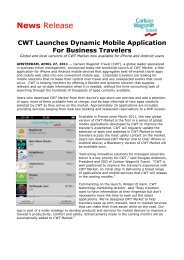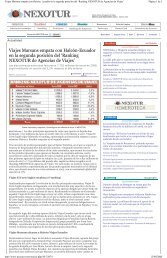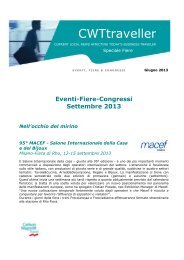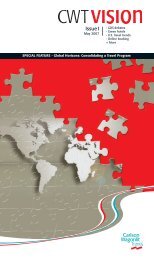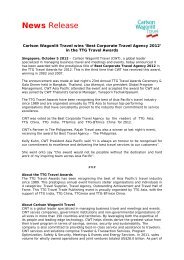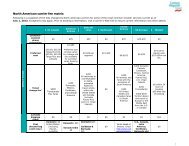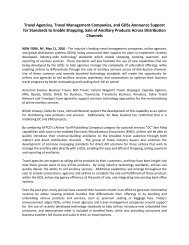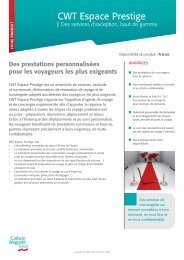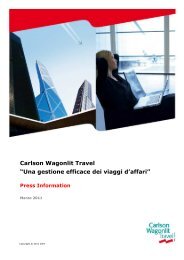Getting With the Program - Carlson Wagonlit Travel
Getting With the Program - Carlson Wagonlit Travel
Getting With the Program - Carlson Wagonlit Travel
You also want an ePaper? Increase the reach of your titles
YUMPU automatically turns print PDFs into web optimized ePapers that Google loves.
CWTvIsIon Issue 3 - January 20083How can travel managers make <strong>the</strong> most of <strong>the</strong>se low-cost carriers in <strong>the</strong>ir travelprogram?Carefully compare providers. Apart from <strong>the</strong> choice of routes and schedules, lowcostcarriers can vary widely in terms of <strong>the</strong> amenities and level of service <strong>the</strong>y offer.It can be a good idea to start small with one or two carriers that fit <strong>the</strong> company’sneeds. Ideally, those carriers should provide <strong>the</strong>ir inventory to a GDS. If not, a travelmanagement company like CWT can provide a Webfare booking interface on acase-by-case basis.Consider moving to a “best buy” policy on routes where price competition isstrong between preferred providers. In Australia and India, <strong>the</strong> fact that air supplyoutweighs demand makes spot buying a logical, cost-effective approach. In fact, itaccounts for 60 percent of companies’ domestic transactions in Australia.Recommend advance booking and communicate on <strong>the</strong> potential savings.Studies show that significant savings are possible even if travelers exchange a largeproportion of tickets. Contrary to popular belief, low-cost fares can be more flexiblethan full-service economy as <strong>the</strong>y are often exchangeable and do not carryrestrictions such as a compulsory Saturday-night stay.If no hard mandate is in place, consider providing incentives for employees touse low-cost airlines. For example, with each trip, <strong>the</strong> traveler could enter a prizedrawing sponsored by <strong>the</strong> airline. Combined with communications on <strong>the</strong> financialbenefits for <strong>the</strong> company, incentives can help boost compliance with travel policy.Exploit potential synergies with an online booking campaign as part of <strong>the</strong>company’s drive to better manage costs.Impressive savings potentialCWT clients who are willing to shift market share in Asia Pacific to low-cost carriers haveidentified impressive savings potential.In Australia, for example, a leading international energy company identified 10 percentsavings (US$100,000 on total national air spend of US$1 million) by switching 30percent of traffic to a low-cost carrier. This involved a best-buy approach on routes whichwould not require any compromise in terms of flight frequency.In India, an international consulting company calculated that it could save 5 percent onair spend by moving some volume to low-cost alternatives and consolidating travel withpreferred airlines. The company had evaluated its domestic air spend at US$8.2 million,having seen its payroll multiply by 100 over <strong>the</strong> previous three years. As a number oflocal contracts with airlines were expiring, <strong>the</strong> organization reviewed its strategy both ata national and regional level, including an in-depth analysis of <strong>the</strong> Indian airline marketand different market share scenarios. This indicated savings of US$400,000.



